Like in the USA there are no breeds of livestock guarding dogs, they make use of “the old World Dogs for the New World”. Among the breeds, which are the most used in the USA for guarding the stock are quoted the Great Pyrenees, the Komondor, the Akbash, the Anatolian, the Maremma, the Sarplaninac and the Kuvasz.
Let’s see now which breeds of dogs from this group exist on the other continents.
| In Europe | In Asian | ||
| Bulgaria | Karakatchansko kuche | Afghanistan |
Sage Koochi |
| Bosnia et Croatia | Tornjak | Armenia | Gampyr |
| Spain | Mastin Espagnol | Iran | Sage Mazandarani |
| Mastin de los Pyrineos | Kirghistan | Kirghizskaya ovcharka | |
| France | Chien des Montagnes des Pyrénées | Mongolia | Buryato |
| Greece | Hellenicos Poimenicos | Nepal | Bhotia |
| Hungary | Komondor | Uzbekistan | Torkuz |
| Kuvasz | Sarkangik | ||
| Italy | Cane di Pastore Maremmano-Abruzzese | Tajikistan | Dahmarda |
| Macedonia | Sarplaninac | Tibet | Do Khyi |
| Poland | Polski Ovczarek Podhalanski | Turkmenistan | Alabay Koyunchi |
| Portugal | Cao da Serra da Estrela | Turkey |
Akbach |
| Cao de Castro Laboreiro | Chien de berger d’Anatolie | ||
| Rafeiro do Alentejo | Kangal Kopegi | ||
| Romania | Ciobanesc romanesc Carpatin | Only
the Dog of Tibet and the Anatolian shepherd are breeds of dogs acknowledged
by the FCI. In all the Republics of the ex-USSR, which are in the Caucasian region, there are existing breeds, similar to the Middle Asiatic Shepherd. |
|
| Mioritic | |||
| Russia | Chien de berger du Caucase | In Africa | |
| Chien de berger d’ Asie Centrale | Morocco |
Aidi | |
| Berger de Russie Méridionale | All the breeds which are not acknowledged by the FCI are indicated in italic. | ||
| Serbia | Sarplaninac | ||
| Srpski pastirski pas | |||
| Slovakia | Slovensky Cuvac | ||
| Slovenia | Kraski ovcar | ||
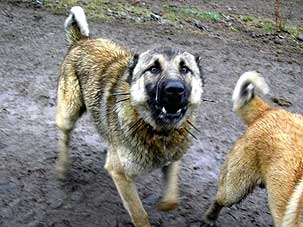
Recently I had the opportunity to receive via Mr. Jean-Jacques Allard some pictures from those countries, made by a big traveller and dog lover, Mr. Philippe Deltreuil. Most of those pictures come from Armenia.
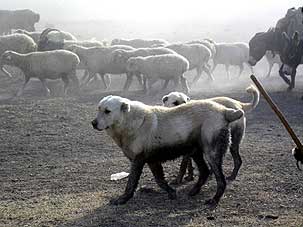
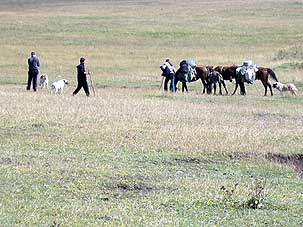
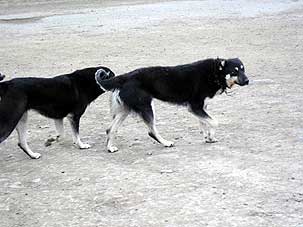
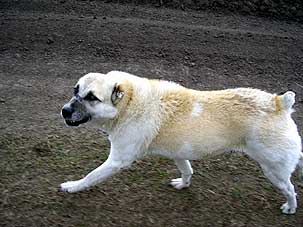
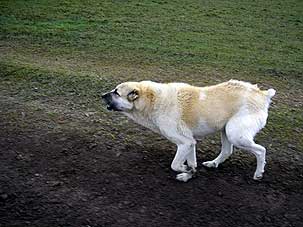
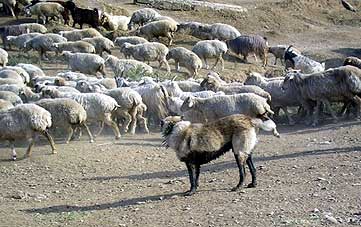
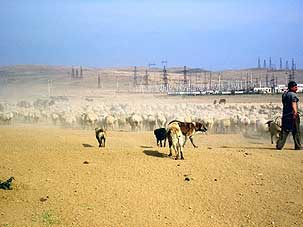
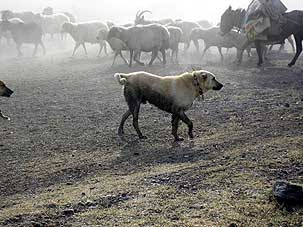
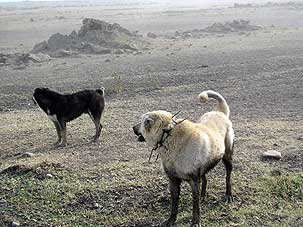
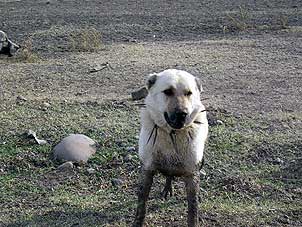
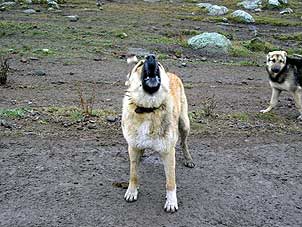
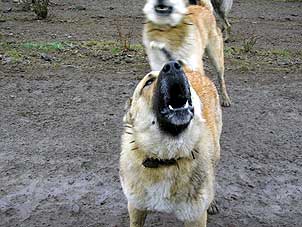
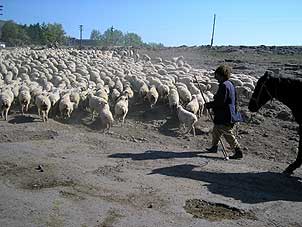

The FCI classification leads to confusion, because certain dogs “protector”
of the flock are classified in group I, group of the shepherds and others
in group II, in the section of Molossoïdes mountain type. The common
characteristic is that all those dogs are mountain dogs with two exceptions:
the Komondor and the Kuvasz.
All those breeds have the instinct of protection in their genetic patrimony.
The work of protecting from an adult dog will be the result of its heritance
and from its integration into the flock life assimilated to the “pack”.
To be a good protecting dog, the dog has first of all to act independently,
he has to be able to take decisions when needed, he should not at all
have the instinct of hunting in his heritance; he should not be too rough,
and not too playful towards the sheep. On the other hand the sheep should
be a breed which stays together, in a flock, not too much dispersed, otherwise
the dog will not get the feeling of living in the pack and will not enough
get attached to them.
The preparation of the puppy to its future task of guarding the flock
starts at the age of 7 to 8 weeks. The puppy will be separated from all
other dogs that made up its pack, as well from the shepherds family. It
will see the least possible humans. It will be put in a pen of about 15
m² with 3 to 6 lamb or ewe-lamb when lack of lamb and will have a
little corner for him, where he can eat and rest. It is necessary to change
the cohabitants, so that the dog can get used to other sheep of the flock,
which he will have to guard. In the first period, when a sheep is showing
itself too aggressive towards the puppy, it has to be replaced by another,
friendlier one. The purpose is that the dog is getting attached to the
flock, much more then to its master and his family, that he is not escaping
and going back to the house. Playing with the lambs will reinforce its
bond with them, but the game should not become too violent. The dog should
not follow other wandering dogs or those from the farm. On the other side,
it should correctly act in presence of the dogs who are conducting the
flock, who are not independent and work on the commands of the shepherd.
The difference between those two groups of dogs is that the herding dogs
of the flock consider the livestock as their prey but with an instinct
of inhibited predation while the protecting dogs consider the livestock
as equal species to themselves.
The puppy becomes operational between 6 to 8 months or later, depending
from the breed. It is not necessarily to demand from it to be aggressive;
its behaviour can be dissuasive or can consist in distracting the attention
of the predator. Those dogs reach only full maturity between 2 and 3 years.
The number of dogs necessary to protect the flock will depend on the configuration
of the land, the size of the flock and the density of the predators. Often
when they are two dogs you can notice that one stays incorporated in the
flock and the other one is mounting guard.
It concerns rather remarkable dogs and having a weight of about 50 kg.
Their colour is very often, but not always, the one of the sheep they
guard.
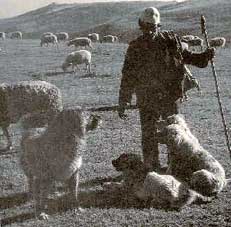
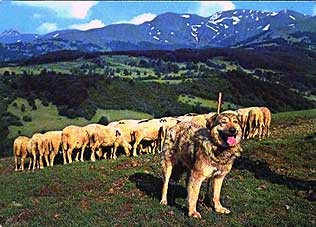
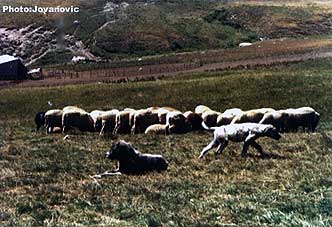

Let’s go back to the anecdote about Pasa reported by my friend Jelena.
Here is what his owner told about him:
“It is very interesting that although he was not going after the sheep (and even we did not let him approach them, because we were afraid that he was going to attack them) he knew the sheep. Once when we sold the sheep to another village 20 km away, he simply disappeared for several days. When he came back, we heard that he had found back the sheep, which were sold and that he stayed with them for a couple of days. He accompanied them when they were grazing and he slept next to the sheep pen. The people who bought the sheep understood what all is about and they fed him. At a certain moment he judged that the flock was not belonging to him anymore and he came back.”